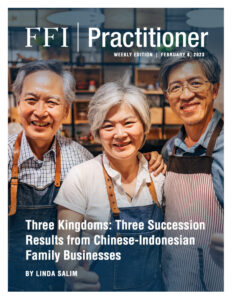
View this edition in our enhanced digital edition format with supporting visual insight and information.
Thanks to the FFI Asian Circle Virtual Study Group and Linda Salim for this week’s edition featuring mini-cases on succession planning in three Chinese-Indonesian family enterprises with lessons for advisors around the world.
Indonesia is home to eight million Chinese, three percent of the country’s total population.1 They had been sojourners in Indonesia since the thirteenth century, but the bulk of migration came in the 1800s as a result of the Chinese diaspora. They had come as merchants. Some intermarried with the locals. Some concealed their identities to avoid limitations imposed on them during Suharto presidency in the 1960s.
In the 1960s, the Indonesian government discouraged Chinese-Indonesian participation in nation building and activities outside of trading. As a result, many Chinese-Indonesians established businesses, employing family and relatives. During the economic boom of the 1970s and the 1980s, these family businesses became fairly wealthy, although many Chinese-Indonesians still live below the poverty line.
The result from this growth is that most Chinese-Indonesian family businesses are in their founder or second generation. Most leaders do not talk about ownership much. Business ownership is often collective, with family members with little or no ownership proudly holding on to affiliation with the family businesses. Nevertheless, inheriting ownership is a sensitive issue. It implies that someone has passed away. Succession decisions are usually made early on, through primogeniture or talent scouting by the parents when children are young.
Inheritance law in Indonesia is straightforward: half of the wealth of a deceased man without a will goes to the wife, with the rest split evenly among children. For those with a prenuptial agreement, the wealth is split evenly among the wife and children. A deceased woman’s wealth is split evenly among children.
Children who are drawn to the industry become apprentices—often to their parents. The young apprentices then become embedded into the businesses, replacing the parents’ leadership as they pass away. Most commonly, the business is inherited and split down the generations, with every branch of the family making decisions about which co-owners will be involved in the business.
Succession as a Method of Continuity
I became a partial owner in my family’s two plastic manufacturing plants as soon as I became an adult. Adulthood starts at 18 years old, when an Indonesian citizen is entitled to legal asset ownership. I became a member of the board as soon as I resided back in Indonesia. Cross holdings of companies are also common; I became the director of one company while my sister became a commissioner in the company where I was the director, and vice versa. The rest of the companies, owned by my parents, will be inherited by the both of us, along with a third sister who does not have ownership as she did not sign a prenuptial agreement. This is on paper and is my father’s way of securing wealth for the next generation.
In reality, I was not involved in the businesses beyond the years I was building the second plant for them. Afterwards, I continued to pursue my own career as a serial entrepreneur. My sister tells a different story. She, too, had her first Indonesian job at the plant until she got married. When her children were old enough, she went back to work in the business as financial controller, taking my mother’s position. Throughout the years, she took more responsibilities that had previously been handled by female family employees. Eventually she made her way up to CFO. Major financial decisions were still decided by my father. Only after my father passed away did she step into full leadership, where she is the de facto decision maker, not just the implementer of what my father decided.
This style of transition as a method of business continuity is common between baby boomers and Generation X. While transition ultimately depends on the character and leadership style of the founder, it’s common for the process to stall until the father passes away.
Chinese-Indonesian baby boomers grew up in hardship. Most lived in poverty, migrated to Indonesia at a young age, and/or experienced various political conflicts from the independence war and WWII. This encouraged baby boomers to make rigid, foolproof plans for the next generations so they would not have to go through the same hardship.
Succession as a Group Decision
The second case involves a son and two daughters. The family’s electrical and mechanical contracting business was started by a former auto dealership manager in the late 1990s. When I interviewed them in 2016, the son had just joined the business. The daughters were recently married and not involved in the business. I probed the founder, asking if the daughters would get shares in the business, to which the founder asked if that was the case in other families; I said yes. There is no regulation in Indonesia to govern the right to inheritance based on gender.
When the son joined the business, he tackled financial issues, in line with his background in finance. He leveraged these skills before being given larger responsibilities. Over time he was put in charge of operations while his father started to step back. The transition was sped up during the pandemic but the father still has veto power.
In the beginning, this founder planned only for his son’s future, assuming his daughters would be cared for by their husbands. Along the way, through conversations with his children, he adjusted his plans. His son recently started a business with friends, in which one of the sisters became a shareholder and operating partner. This family involved the children in succession planning, catering to their needs and interests. The youngest runs a business with her husband, independent of her parents.
This second case is a common transition between the first and second generations, where plans are adaptable. These leaders work to rethink the future of the business to serve the needs, interests, and voices of the children. Founders of this generation are likely to have built the business on better financial positions and education than baby boomers. On the children’s part, compared to the previous generation, the younger generation is more likely to speak up to their parents and pursue their career goals.
Succession as a Legacy
The third case is of a family of successors in farming equipment manufacturing, where a second-generation member emerged into leadership in an unlikely turn of events. As the son of his father’s second wife, the second-generation leader began nowhere near the leadership. Upon the death of his father, the first wife negotiated for him to become the founder’s successor. She believed her stepson would be a better leader than her own children. This proved true—the second-generation leader was so successful that he ended up buying out his step siblings’ shares.
Despite having concurrent wives, the founder did not overlook potential conflicts. Children from both wives were treated fairly and socialized. Assets were split among the two wives and adult children, ensuring wealth distribution for all.
After buying out his step siblings’ shares, the second-generation leader co-owned the business with his brother. Ownership of the company now fully belonged to the sons of the second wife. Later on, the second-generation leader invited his sons and nieces to join the business as they entered adulthood. Learning from his family history, he exerted controlled freedom on the next generations. He worked with individual talents and interests to fulfill everyone’s need for achievements. He mentored his grandchildren and exposed them to the working environment.
As a successor himself, the second-generation leader was more aware of potential conflicts that could arise during transitions. He moved leadership transition along with the next generation in mind, securing each member’s position. Both of his sons, members of the third generation, ventured into new business units relevant to the main business. The second-generation leader recently passed away. His sons continue to work alongside their cousins, with the oldest son stepping up as the successor.
Working with Chinese-Indonesian Family Businesses
Leadership transition in a family business works like the two wheels of a bicycle. The front wheel, the leading generation, initiates and directs the process. The back wheel, the rising generation, supports it. Without that support, the bicycle—the transition process—goes nowhere. The two wheels are of equal power, but they function differently. In the same way, both generations’ alignment and participation are important for succession to happen smoothly.
Family business requires a willingness to normalize conflict in succession planning, which many Chinese-Indonesian family businesses try to avoid. Conflict is not a life stage nor is it a weakness. It does not have to be divisive. Family businesses should focus on commonalities to return to what is keeping them together.
Practitioners advising a Chinese-Indonesian family business should strive to get to know the family and build relationships with each member to grasp a holistic understanding of the family. Preserving relationships among family members in the long run is imperative. Sometimes, the most powerful and influential family member may not be visible in the business.
Hierarchical families, as seen in the first case, do not fare well with open honesty. In fact, these families focus more on the sense of responsibilities and collective purposes. “Keeping the peace” is the name of the game. Practitioners can work with successors and continue to coach them to improve future processes. Less hierarchical families, as seen in the latter cases, can benefit from best practices because members are more aware of each other’s voices.
Reference
1 World Population Review. (n.d.). [Indonesia Population 2022 (live)]. Retrieved December 22, 2022, from https://worldpopulationreview.com/countries/indonesia-population
About the contributor

Linda Salim, PhD, is the CEO of Daftaro, a health tech platform in Indonesia and Malaysia. Serving on the boards of multiple family businesses within her family branches, Linda finds purpose in bridging communications between generations in family businesses. She advises family businesses in transition, mentors college students, and coaches professionals. She can be reached at linda@daftaro.com.

View this edition in our enhanced digital edition format with supporting visual insight and information.





